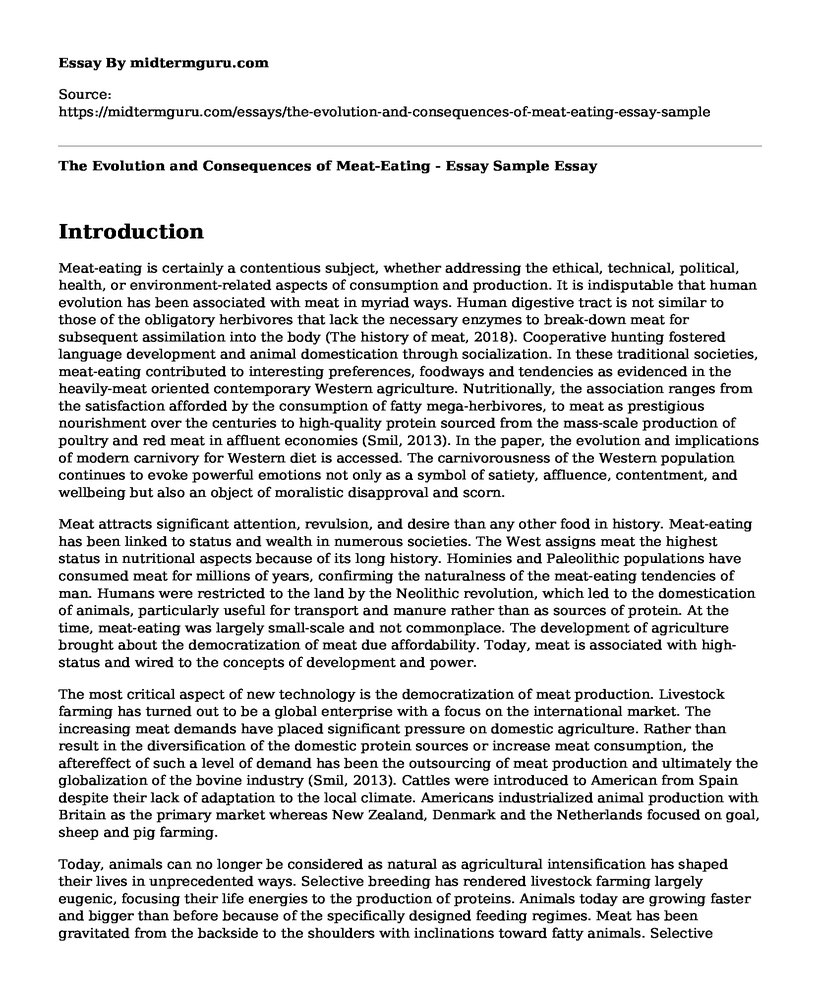Introduction
Meat-eating is certainly a contentious subject, whether addressing the ethical, technical, political, health, or environment-related aspects of consumption and production. It is indisputable that human evolution has been associated with meat in myriad ways. Human digestive tract is not similar to those of the obligatory herbivores that lack the necessary enzymes to break-down meat for subsequent assimilation into the body (The history of meat, 2018). Cooperative hunting fostered language development and animal domestication through socialization. In these traditional societies, meat-eating contributed to interesting preferences, foodways and tendencies as evidenced in the heavily-meat oriented contemporary Western agriculture. Nutritionally, the association ranges from the satisfaction afforded by the consumption of fatty mega-herbivores, to meat as prestigious nourishment over the centuries to high-quality protein sourced from the mass-scale production of poultry and red meat in affluent economies (Smil, 2013). In the paper, the evolution and implications of modern carnivory for Western diet is accessed. The carnivorousness of the Western population continues to evoke powerful emotions not only as a symbol of satiety, affluence, contentment, and wellbeing but also an object of moralistic disapproval and scorn.
Meat attracts significant attention, revulsion, and desire than any other food in history. Meat-eating has been linked to status and wealth in numerous societies. The West assigns meat the highest status in nutritional aspects because of its long history. Hominies and Paleolithic populations have consumed meat for millions of years, confirming the naturalness of the meat-eating tendencies of man. Humans were restricted to the land by the Neolithic revolution, which led to the domestication of animals, particularly useful for transport and manure rather than as sources of protein. At the time, meat-eating was largely small-scale and not commonplace. The development of agriculture brought about the democratization of meat due affordability. Today, meat is associated with high-status and wired to the concepts of development and power.
The most critical aspect of new technology is the democratization of meat production. Livestock farming has turned out to be a global enterprise with a focus on the international market. The increasing meat demands have placed significant pressure on domestic agriculture. Rather than result in the diversification of the domestic protein sources or increase meat consumption, the aftereffect of such a level of demand has been the outsourcing of meat production and ultimately the globalization of the bovine industry (Smil, 2013). Cattles were introduced to American from Spain despite their lack of adaptation to the local climate. Americans industrialized animal production with Britain as the primary market whereas New Zealand, Denmark and the Netherlands focused on goal, sheep and pig farming.
Today, animals can no longer be considered as natural as agricultural intensification has shaped their lives in unprecedented ways. Selective breeding has rendered livestock farming largely eugenic, focusing their life energies to the production of proteins. Animals today are growing faster and bigger than before because of the specifically designed feeding regimes. Meat has been gravitated from the backside to the shoulders with inclinations toward fatty animals. Selective feeding and breeding regimes mean that animals reach maturity at a relatively faster. There is a shift from traditional grass feedstock to concentrated feeds, grains, fish meals and soy. According to The history of meat (2018), by 2000, over forty percent of the global grain production was converted to feeds to quicken animals' life cycles. The giant pharmaceutical companies introduced chlortetracycline and penicillin as feed additives to support mass production following their approval by their Food and Drug Agency.
According to Smil (2013), the body and experience of animals were transformed significantly, and their reproductive capacities amplified. Those with weaker reproductive capacities were phased through castration and spraying. Artificial insemination was introduced for breed selection, bringing about the industrialization of livestock (Smil, 2013). Animals, particularly poultry grew rapidly, converting their food into meat for human consumption. Today, the figures are startling with Americans consuming more chicken than beef, which characterizes the western diet. The broiler industry support year-round production and supply of poultry meat with hybrid becoming the basis of the industry. Vertical integration was introduced to merge the dissociated elements of the sector into a tight chain.
The whole complex, the feeding and new breeds, steamships, industrialized slaughter and refrigeration rendered the meat-eating behavior commonplace. Presently, the consumption level of meat has increased tremendously and global consumption and global production of going over three hundred megatons from fifty megatons. Such a growth in intake has raised more health and moral questions (Smil, 2013). The food is today associated with more strength and power with food reformers advocating for the democratization of meat consumption to combat physical exhaustion and enhance stamina. Similar voices remain unchallenged yet meat remains the primary vector for diseases, such as tuberculosis and other lifestyle-related conditions.
Conclusion
The trend needs to be brought to a halt and reversed to ensure the world population supports rational spending and one that is within their means. Unfortunately, such adjustments cannot be gradual, which brings renewed concerns on the possibility of recurrence and the future of food supply. The skyrocketing prices of food in affluent countries would certainly lower meat consumption although its impacts on food security in the developing nation remain unclear.
References
Smil, V. (2013). Should we eat meat?: Evolution and consequences of modern carnivory.
Chichester, West Sussex: Wiley-Blackwell.
The history of meat. (2018) Class Notes. University Press.
Cite this page
The Evolution and Consequences of Meat-Eating - Essay Sample. (2022, Sep 28). Retrieved from https://midtermguru.com/essays/the-evolution-and-consequences-of-meat-eating-essay-sample
If you are the original author of this essay and no longer wish to have it published on the midtermguru.com website, please click below to request its removal:
- Whether Vegetarianism Is Healthier Than Eating Meat - Essay Example
- Paper Example on Food Consumption Practices
- Paper Example on Plant-Based Diet to Reverse/Prevent Cardiovascular Disease
- SMART Goals: Diet Analysis Project
- Nutrition Science and Its Benefits: Beyond Weight Management - Essay Sample
- Fad Diets - Essay Sample
- Celiac Disease: Foods to Avoid, Gluten-Free Diet & Health Benefits - Essay Sample







